NUR222: Applying Ethical and Legal Principles in Nursing Practice
VerifiedAdded on 2022/10/13
|11
|3626
|25
Homework Assignment
AI Summary
This assignment delves into the legal and ethical responsibilities of registered nurses and midwives, focusing on their obligations in patient care. It examines the implications of various statutes and guidelines, including NMBA standards, the Civil Liability Act, and the Health Ombudsman Act, through the analysis of three case studies. The first case explores informed consent in gynaecology procedures, highlighting ethical dilemmas for a student nurse. The second case investigates infection control practices within a hospital setting, addressing non-compliance with hand hygiene and its impact on patient safety. The third case focuses on a student nurse's substance abuse, discussing the ethical and legal ramifications of drug-related misconduct. Each case study requires an analysis of the legal requirements for different nursing roles, the implications for healthcare facilities and educational providers, and a reflection on personal experiences and decision-making processes. The assignment emphasizes the importance of ethical conduct, adherence to professional standards, and the application of relevant legislation in nursing practice. This assignment aims to enhance the understanding of ethical principles and the application of legal requirements in various nursing scenarios, preparing future nurses for the complexities of their profession.
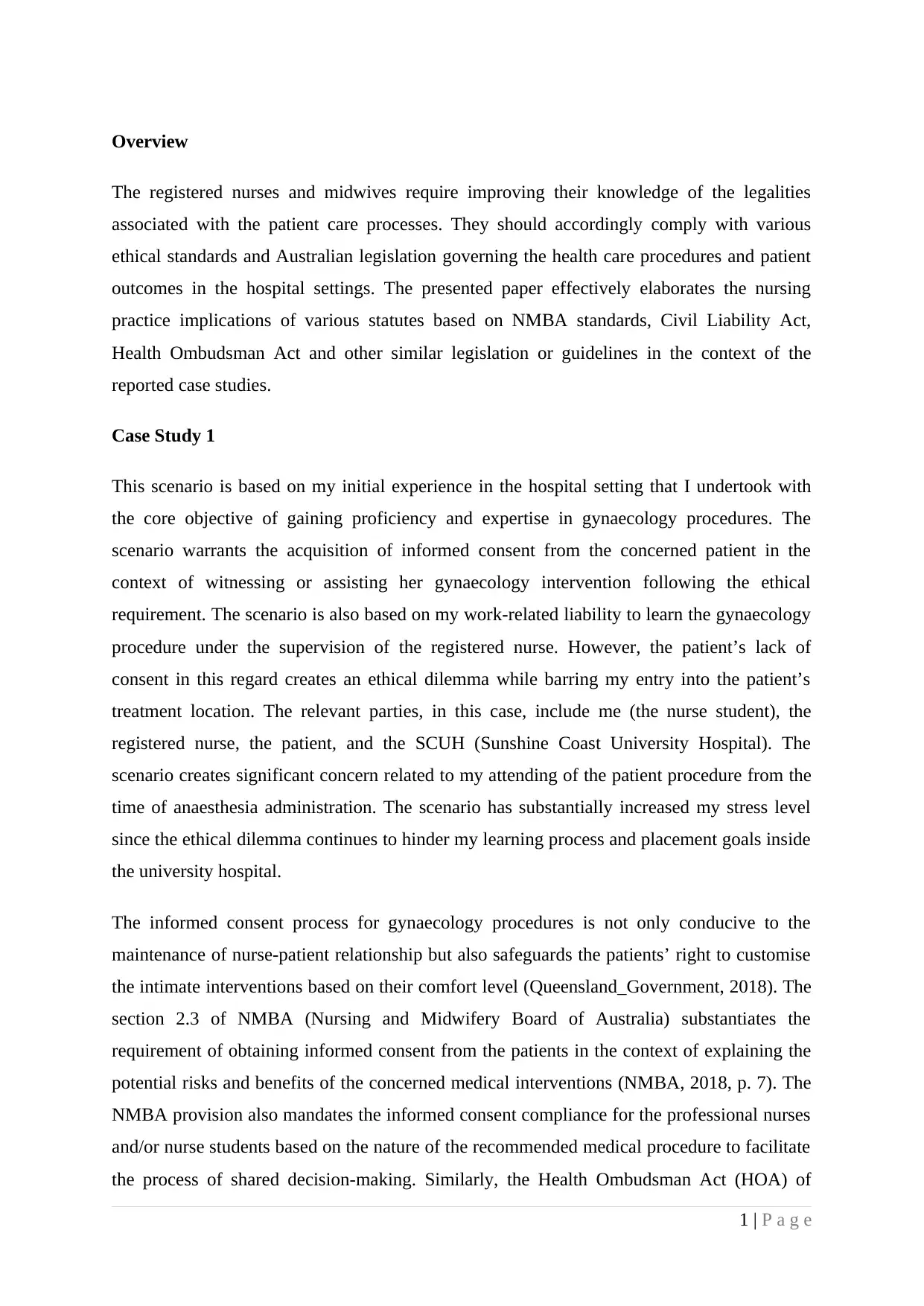
Overview
The registered nurses and midwives require improving their knowledge of the legalities
associated with the patient care processes. They should accordingly comply with various
ethical standards and Australian legislation governing the health care procedures and patient
outcomes in the hospital settings. The presented paper effectively elaborates the nursing
practice implications of various statutes based on NMBA standards, Civil Liability Act,
Health Ombudsman Act and other similar legislation or guidelines in the context of the
reported case studies.
Case Study 1
This scenario is based on my initial experience in the hospital setting that I undertook with
the core objective of gaining proficiency and expertise in gynaecology procedures. The
scenario warrants the acquisition of informed consent from the concerned patient in the
context of witnessing or assisting her gynaecology intervention following the ethical
requirement. The scenario is also based on my work-related liability to learn the gynaecology
procedure under the supervision of the registered nurse. However, the patient’s lack of
consent in this regard creates an ethical dilemma while barring my entry into the patient’s
treatment location. The relevant parties, in this case, include me (the nurse student), the
registered nurse, the patient, and the SCUH (Sunshine Coast University Hospital). The
scenario creates significant concern related to my attending of the patient procedure from the
time of anaesthesia administration. The scenario has substantially increased my stress level
since the ethical dilemma continues to hinder my learning process and placement goals inside
the university hospital.
The informed consent process for gynaecology procedures is not only conducive to the
maintenance of nurse-patient relationship but also safeguards the patients’ right to customise
the intimate interventions based on their comfort level (Queensland_Government, 2018). The
section 2.3 of NMBA (Nursing and Midwifery Board of Australia) substantiates the
requirement of obtaining informed consent from the patients in the context of explaining the
potential risks and benefits of the concerned medical interventions (NMBA, 2018, p. 7). The
NMBA provision also mandates the informed consent compliance for the professional nurses
and/or nurse students based on the nature of the recommended medical procedure to facilitate
the process of shared decision-making. Similarly, the Health Ombudsman Act (HOA) of
1 | P a g e
The registered nurses and midwives require improving their knowledge of the legalities
associated with the patient care processes. They should accordingly comply with various
ethical standards and Australian legislation governing the health care procedures and patient
outcomes in the hospital settings. The presented paper effectively elaborates the nursing
practice implications of various statutes based on NMBA standards, Civil Liability Act,
Health Ombudsman Act and other similar legislation or guidelines in the context of the
reported case studies.
Case Study 1
This scenario is based on my initial experience in the hospital setting that I undertook with
the core objective of gaining proficiency and expertise in gynaecology procedures. The
scenario warrants the acquisition of informed consent from the concerned patient in the
context of witnessing or assisting her gynaecology intervention following the ethical
requirement. The scenario is also based on my work-related liability to learn the gynaecology
procedure under the supervision of the registered nurse. However, the patient’s lack of
consent in this regard creates an ethical dilemma while barring my entry into the patient’s
treatment location. The relevant parties, in this case, include me (the nurse student), the
registered nurse, the patient, and the SCUH (Sunshine Coast University Hospital). The
scenario creates significant concern related to my attending of the patient procedure from the
time of anaesthesia administration. The scenario has substantially increased my stress level
since the ethical dilemma continues to hinder my learning process and placement goals inside
the university hospital.
The informed consent process for gynaecology procedures is not only conducive to the
maintenance of nurse-patient relationship but also safeguards the patients’ right to customise
the intimate interventions based on their comfort level (Queensland_Government, 2018). The
section 2.3 of NMBA (Nursing and Midwifery Board of Australia) substantiates the
requirement of obtaining informed consent from the patients in the context of explaining the
potential risks and benefits of the concerned medical interventions (NMBA, 2018, p. 7). The
NMBA provision also mandates the informed consent compliance for the professional nurses
and/or nurse students based on the nature of the recommended medical procedure to facilitate
the process of shared decision-making. Similarly, the Health Ombudsman Act (HOA) of
1 | P a g e
Paraphrase This Document
Need a fresh take? Get an instant paraphrase of this document with our AI Paraphraser
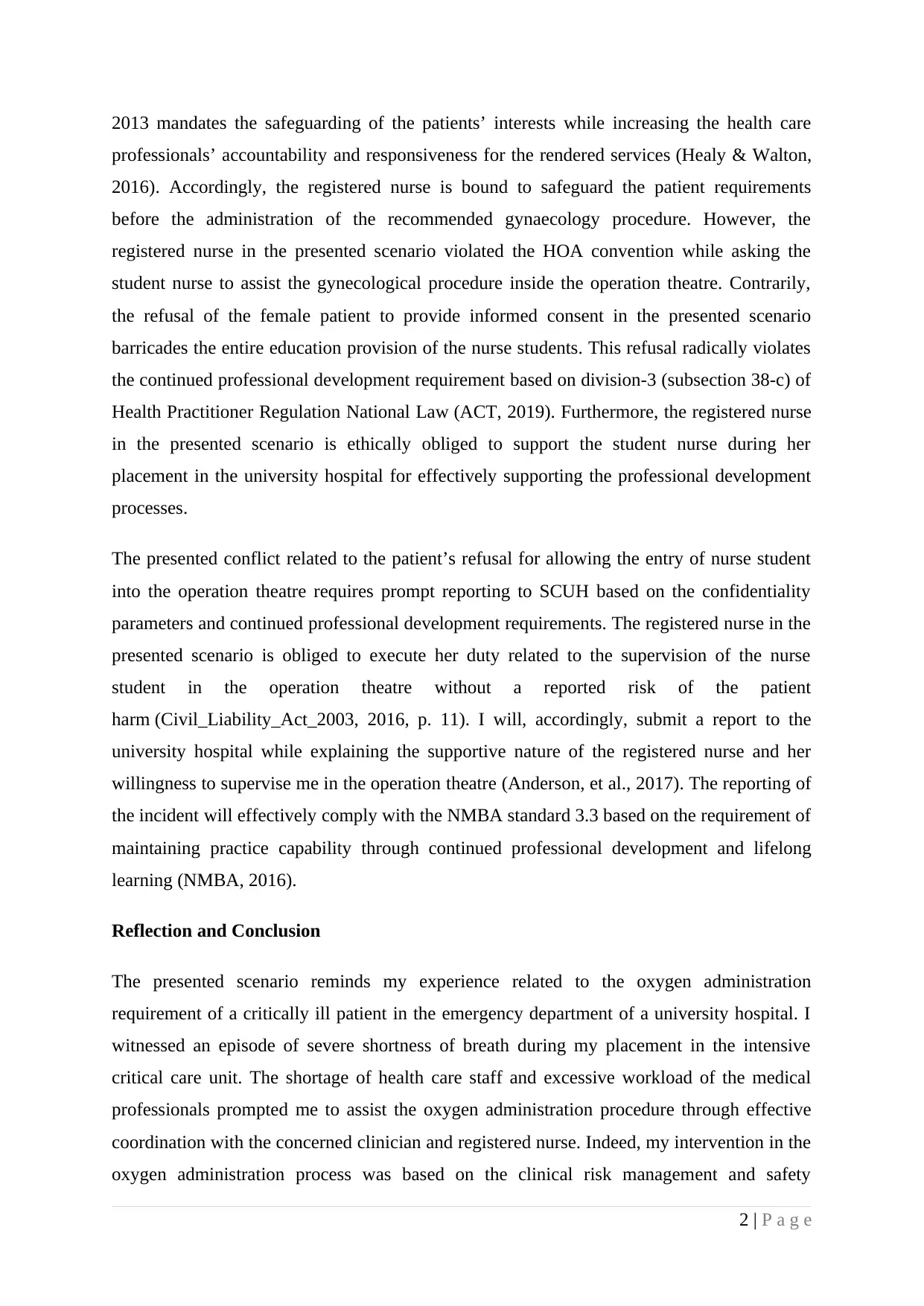
2013 mandates the safeguarding of the patients’ interests while increasing the health care
professionals’ accountability and responsiveness for the rendered services (Healy & Walton,
2016). Accordingly, the registered nurse is bound to safeguard the patient requirements
before the administration of the recommended gynaecology procedure. However, the
registered nurse in the presented scenario violated the HOA convention while asking the
student nurse to assist the gynecological procedure inside the operation theatre. Contrarily,
the refusal of the female patient to provide informed consent in the presented scenario
barricades the entire education provision of the nurse students. This refusal radically violates
the continued professional development requirement based on division-3 (subsection 38-c) of
Health Practitioner Regulation National Law (ACT, 2019). Furthermore, the registered nurse
in the presented scenario is ethically obliged to support the student nurse during her
placement in the university hospital for effectively supporting the professional development
processes.
The presented conflict related to the patient’s refusal for allowing the entry of nurse student
into the operation theatre requires prompt reporting to SCUH based on the confidentiality
parameters and continued professional development requirements. The registered nurse in the
presented scenario is obliged to execute her duty related to the supervision of the nurse
student in the operation theatre without a reported risk of the patient
harm (Civil_Liability_Act_2003, 2016, p. 11). I will, accordingly, submit a report to the
university hospital while explaining the supportive nature of the registered nurse and her
willingness to supervise me in the operation theatre (Anderson, et al., 2017). The reporting of
the incident will effectively comply with the NMBA standard 3.3 based on the requirement of
maintaining practice capability through continued professional development and lifelong
learning (NMBA, 2016).
Reflection and Conclusion
The presented scenario reminds my experience related to the oxygen administration
requirement of a critically ill patient in the emergency department of a university hospital. I
witnessed an episode of severe shortness of breath during my placement in the intensive
critical care unit. The shortage of health care staff and excessive workload of the medical
professionals prompted me to assist the oxygen administration procedure through effective
coordination with the concerned clinician and registered nurse. Indeed, my intervention in the
oxygen administration process was based on the clinical risk management and safety
2 | P a g e
professionals’ accountability and responsiveness for the rendered services (Healy & Walton,
2016). Accordingly, the registered nurse is bound to safeguard the patient requirements
before the administration of the recommended gynaecology procedure. However, the
registered nurse in the presented scenario violated the HOA convention while asking the
student nurse to assist the gynecological procedure inside the operation theatre. Contrarily,
the refusal of the female patient to provide informed consent in the presented scenario
barricades the entire education provision of the nurse students. This refusal radically violates
the continued professional development requirement based on division-3 (subsection 38-c) of
Health Practitioner Regulation National Law (ACT, 2019). Furthermore, the registered nurse
in the presented scenario is ethically obliged to support the student nurse during her
placement in the university hospital for effectively supporting the professional development
processes.
The presented conflict related to the patient’s refusal for allowing the entry of nurse student
into the operation theatre requires prompt reporting to SCUH based on the confidentiality
parameters and continued professional development requirements. The registered nurse in the
presented scenario is obliged to execute her duty related to the supervision of the nurse
student in the operation theatre without a reported risk of the patient
harm (Civil_Liability_Act_2003, 2016, p. 11). I will, accordingly, submit a report to the
university hospital while explaining the supportive nature of the registered nurse and her
willingness to supervise me in the operation theatre (Anderson, et al., 2017). The reporting of
the incident will effectively comply with the NMBA standard 3.3 based on the requirement of
maintaining practice capability through continued professional development and lifelong
learning (NMBA, 2016).
Reflection and Conclusion
The presented scenario reminds my experience related to the oxygen administration
requirement of a critically ill patient in the emergency department of a university hospital. I
witnessed an episode of severe shortness of breath during my placement in the intensive
critical care unit. The shortage of health care staff and excessive workload of the medical
professionals prompted me to assist the oxygen administration procedure through effective
coordination with the concerned clinician and registered nurse. Indeed, my intervention in the
oxygen administration process was based on the clinical risk management and safety
2 | P a g e
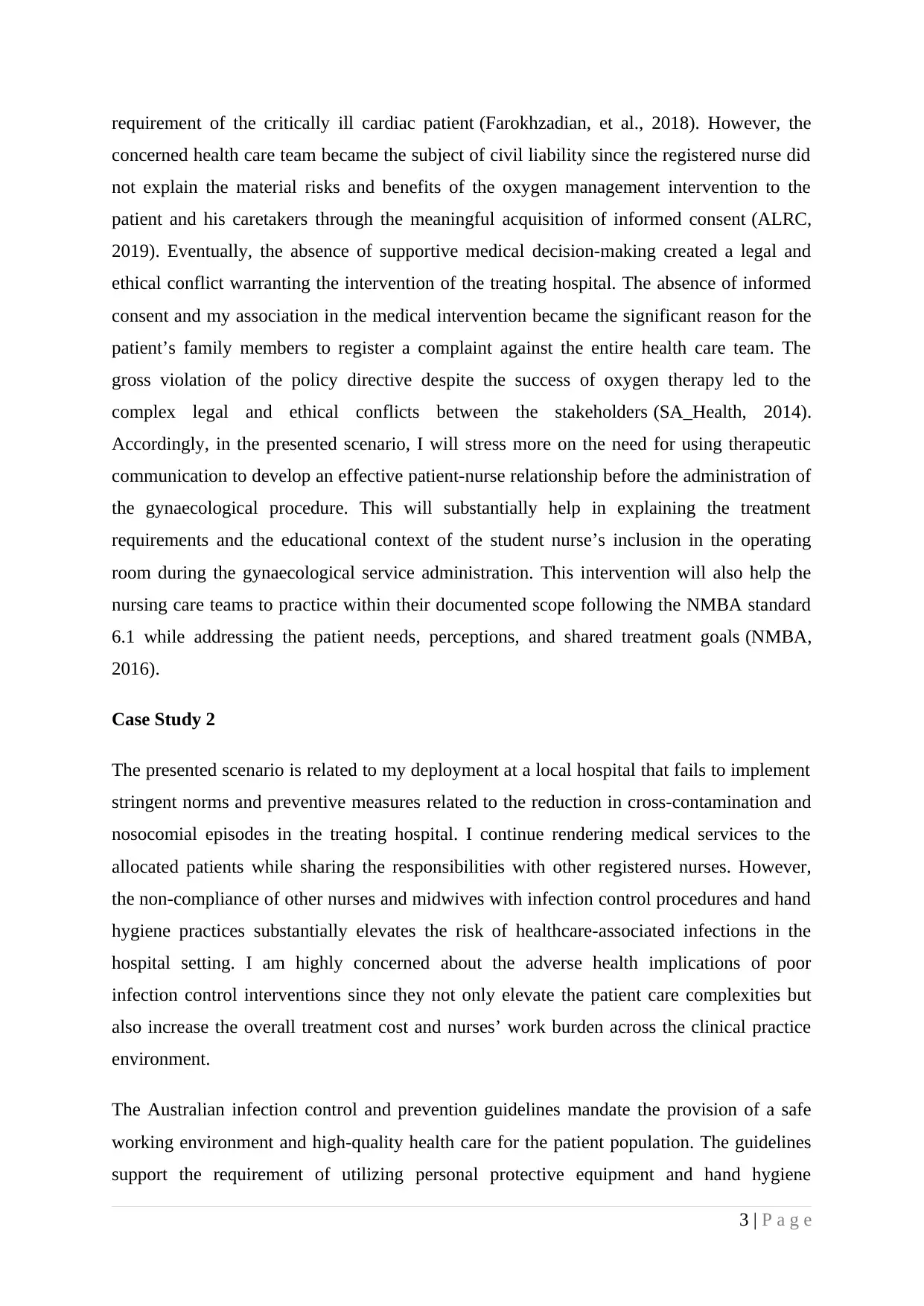
requirement of the critically ill cardiac patient (Farokhzadian, et al., 2018). However, the
concerned health care team became the subject of civil liability since the registered nurse did
not explain the material risks and benefits of the oxygen management intervention to the
patient and his caretakers through the meaningful acquisition of informed consent (ALRC,
2019). Eventually, the absence of supportive medical decision-making created a legal and
ethical conflict warranting the intervention of the treating hospital. The absence of informed
consent and my association in the medical intervention became the significant reason for the
patient’s family members to register a complaint against the entire health care team. The
gross violation of the policy directive despite the success of oxygen therapy led to the
complex legal and ethical conflicts between the stakeholders (SA_Health, 2014).
Accordingly, in the presented scenario, I will stress more on the need for using therapeutic
communication to develop an effective patient-nurse relationship before the administration of
the gynaecological procedure. This will substantially help in explaining the treatment
requirements and the educational context of the student nurse’s inclusion in the operating
room during the gynaecological service administration. This intervention will also help the
nursing care teams to practice within their documented scope following the NMBA standard
6.1 while addressing the patient needs, perceptions, and shared treatment goals (NMBA,
2016).
Case Study 2
The presented scenario is related to my deployment at a local hospital that fails to implement
stringent norms and preventive measures related to the reduction in cross-contamination and
nosocomial episodes in the treating hospital. I continue rendering medical services to the
allocated patients while sharing the responsibilities with other registered nurses. However,
the non-compliance of other nurses and midwives with infection control procedures and hand
hygiene practices substantially elevates the risk of healthcare-associated infections in the
hospital setting. I am highly concerned about the adverse health implications of poor
infection control interventions since they not only elevate the patient care complexities but
also increase the overall treatment cost and nurses’ work burden across the clinical practice
environment.
The Australian infection control and prevention guidelines mandate the provision of a safe
working environment and high-quality health care for the patient population. The guidelines
support the requirement of utilizing personal protective equipment and hand hygiene
3 | P a g e
concerned health care team became the subject of civil liability since the registered nurse did
not explain the material risks and benefits of the oxygen management intervention to the
patient and his caretakers through the meaningful acquisition of informed consent (ALRC,
2019). Eventually, the absence of supportive medical decision-making created a legal and
ethical conflict warranting the intervention of the treating hospital. The absence of informed
consent and my association in the medical intervention became the significant reason for the
patient’s family members to register a complaint against the entire health care team. The
gross violation of the policy directive despite the success of oxygen therapy led to the
complex legal and ethical conflicts between the stakeholders (SA_Health, 2014).
Accordingly, in the presented scenario, I will stress more on the need for using therapeutic
communication to develop an effective patient-nurse relationship before the administration of
the gynaecological procedure. This will substantially help in explaining the treatment
requirements and the educational context of the student nurse’s inclusion in the operating
room during the gynaecological service administration. This intervention will also help the
nursing care teams to practice within their documented scope following the NMBA standard
6.1 while addressing the patient needs, perceptions, and shared treatment goals (NMBA,
2016).
Case Study 2
The presented scenario is related to my deployment at a local hospital that fails to implement
stringent norms and preventive measures related to the reduction in cross-contamination and
nosocomial episodes in the treating hospital. I continue rendering medical services to the
allocated patients while sharing the responsibilities with other registered nurses. However,
the non-compliance of other nurses and midwives with infection control procedures and hand
hygiene practices substantially elevates the risk of healthcare-associated infections in the
hospital setting. I am highly concerned about the adverse health implications of poor
infection control interventions since they not only elevate the patient care complexities but
also increase the overall treatment cost and nurses’ work burden across the clinical practice
environment.
The Australian infection control and prevention guidelines mandate the provision of a safe
working environment and high-quality health care for the patient population. The guidelines
support the requirement of utilizing personal protective equipment and hand hygiene
3 | P a g e
⊘ This is a preview!⊘
Do you want full access?
Subscribe today to unlock all pages.

Trusted by 1+ million students worldwide
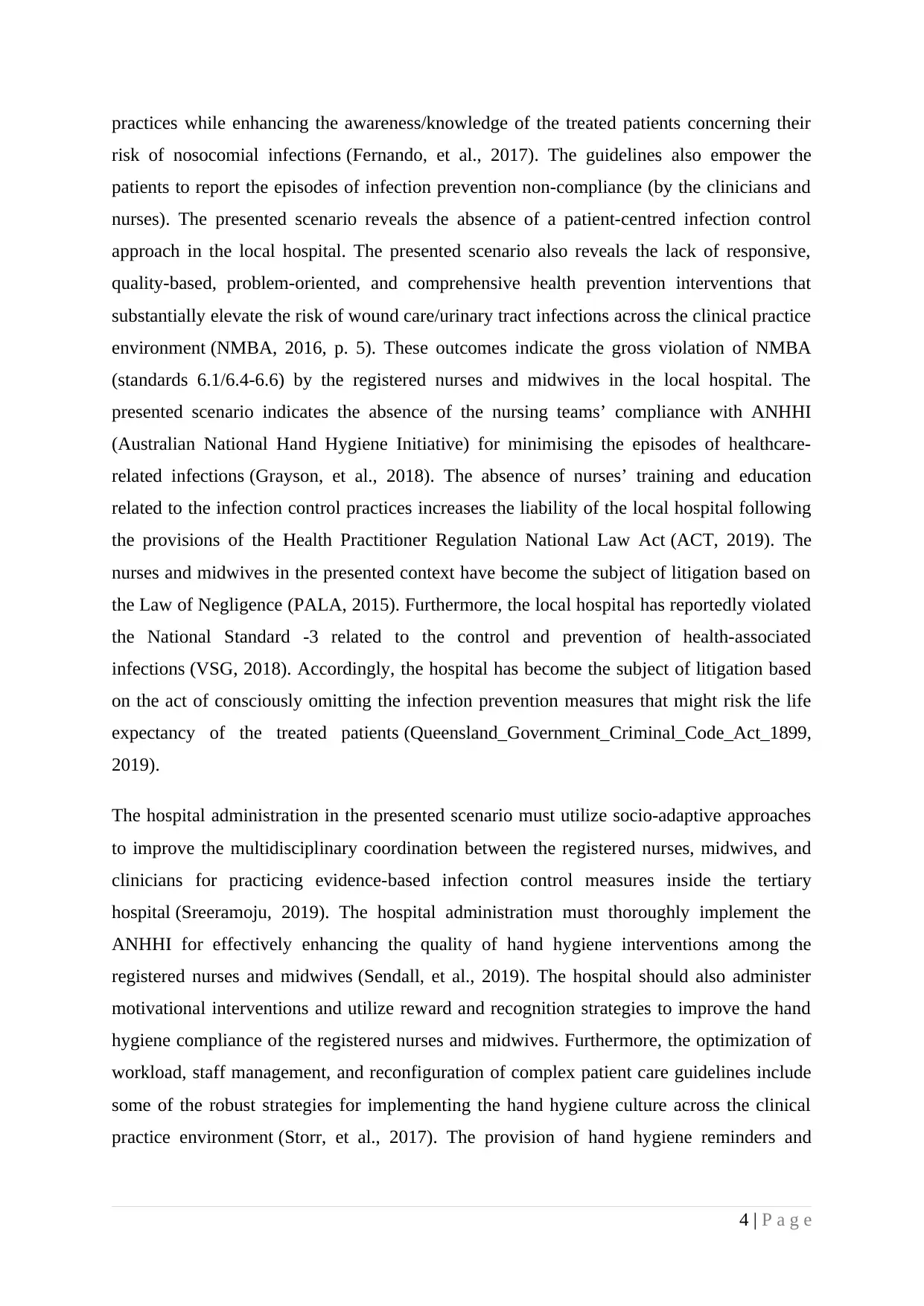
practices while enhancing the awareness/knowledge of the treated patients concerning their
risk of nosocomial infections (Fernando, et al., 2017). The guidelines also empower the
patients to report the episodes of infection prevention non-compliance (by the clinicians and
nurses). The presented scenario reveals the absence of a patient-centred infection control
approach in the local hospital. The presented scenario also reveals the lack of responsive,
quality-based, problem-oriented, and comprehensive health prevention interventions that
substantially elevate the risk of wound care/urinary tract infections across the clinical practice
environment (NMBA, 2016, p. 5). These outcomes indicate the gross violation of NMBA
(standards 6.1/6.4-6.6) by the registered nurses and midwives in the local hospital. The
presented scenario indicates the absence of the nursing teams’ compliance with ANHHI
(Australian National Hand Hygiene Initiative) for minimising the episodes of healthcare-
related infections (Grayson, et al., 2018). The absence of nurses’ training and education
related to the infection control practices increases the liability of the local hospital following
the provisions of the Health Practitioner Regulation National Law Act (ACT, 2019). The
nurses and midwives in the presented context have become the subject of litigation based on
the Law of Negligence (PALA, 2015). Furthermore, the local hospital has reportedly violated
the National Standard -3 related to the control and prevention of health-associated
infections (VSG, 2018). Accordingly, the hospital has become the subject of litigation based
on the act of consciously omitting the infection prevention measures that might risk the life
expectancy of the treated patients (Queensland_Government_Criminal_Code_Act_1899,
2019).
The hospital administration in the presented scenario must utilize socio-adaptive approaches
to improve the multidisciplinary coordination between the registered nurses, midwives, and
clinicians for practicing evidence-based infection control measures inside the tertiary
hospital (Sreeramoju, 2019). The hospital administration must thoroughly implement the
ANHHI for effectively enhancing the quality of hand hygiene interventions among the
registered nurses and midwives (Sendall, et al., 2019). The hospital should also administer
motivational interventions and utilize reward and recognition strategies to improve the hand
hygiene compliance of the registered nurses and midwives. Furthermore, the optimization of
workload, staff management, and reconfiguration of complex patient care guidelines include
some of the robust strategies for implementing the hand hygiene culture across the clinical
practice environment (Storr, et al., 2017). The provision of hand hygiene reminders and
4 | P a g e
risk of nosocomial infections (Fernando, et al., 2017). The guidelines also empower the
patients to report the episodes of infection prevention non-compliance (by the clinicians and
nurses). The presented scenario reveals the absence of a patient-centred infection control
approach in the local hospital. The presented scenario also reveals the lack of responsive,
quality-based, problem-oriented, and comprehensive health prevention interventions that
substantially elevate the risk of wound care/urinary tract infections across the clinical practice
environment (NMBA, 2016, p. 5). These outcomes indicate the gross violation of NMBA
(standards 6.1/6.4-6.6) by the registered nurses and midwives in the local hospital. The
presented scenario indicates the absence of the nursing teams’ compliance with ANHHI
(Australian National Hand Hygiene Initiative) for minimising the episodes of healthcare-
related infections (Grayson, et al., 2018). The absence of nurses’ training and education
related to the infection control practices increases the liability of the local hospital following
the provisions of the Health Practitioner Regulation National Law Act (ACT, 2019). The
nurses and midwives in the presented context have become the subject of litigation based on
the Law of Negligence (PALA, 2015). Furthermore, the local hospital has reportedly violated
the National Standard -3 related to the control and prevention of health-associated
infections (VSG, 2018). Accordingly, the hospital has become the subject of litigation based
on the act of consciously omitting the infection prevention measures that might risk the life
expectancy of the treated patients (Queensland_Government_Criminal_Code_Act_1899,
2019).
The hospital administration in the presented scenario must utilize socio-adaptive approaches
to improve the multidisciplinary coordination between the registered nurses, midwives, and
clinicians for practicing evidence-based infection control measures inside the tertiary
hospital (Sreeramoju, 2019). The hospital administration must thoroughly implement the
ANHHI for effectively enhancing the quality of hand hygiene interventions among the
registered nurses and midwives (Sendall, et al., 2019). The hospital should also administer
motivational interventions and utilize reward and recognition strategies to improve the hand
hygiene compliance of the registered nurses and midwives. Furthermore, the optimization of
workload, staff management, and reconfiguration of complex patient care guidelines include
some of the robust strategies for implementing the hand hygiene culture across the clinical
practice environment (Storr, et al., 2017). The provision of hand hygiene reminders and
4 | P a g e
Paraphrase This Document
Need a fresh take? Get an instant paraphrase of this document with our AI Paraphraser
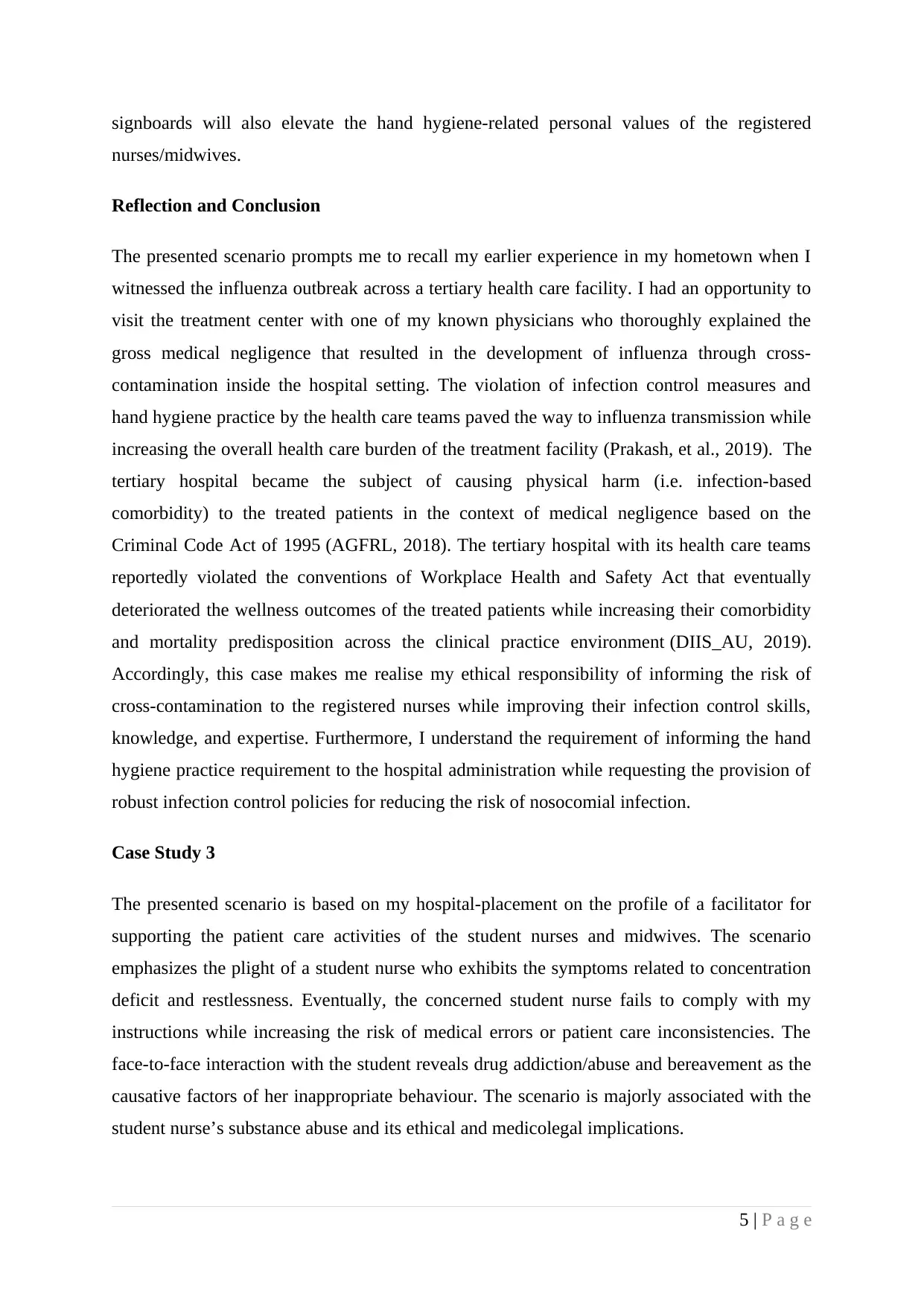
signboards will also elevate the hand hygiene-related personal values of the registered
nurses/midwives.
Reflection and Conclusion
The presented scenario prompts me to recall my earlier experience in my hometown when I
witnessed the influenza outbreak across a tertiary health care facility. I had an opportunity to
visit the treatment center with one of my known physicians who thoroughly explained the
gross medical negligence that resulted in the development of influenza through cross-
contamination inside the hospital setting. The violation of infection control measures and
hand hygiene practice by the health care teams paved the way to influenza transmission while
increasing the overall health care burden of the treatment facility (Prakash, et al., 2019). The
tertiary hospital became the subject of causing physical harm (i.e. infection-based
comorbidity) to the treated patients in the context of medical negligence based on the
Criminal Code Act of 1995 (AGFRL, 2018). The tertiary hospital with its health care teams
reportedly violated the conventions of Workplace Health and Safety Act that eventually
deteriorated the wellness outcomes of the treated patients while increasing their comorbidity
and mortality predisposition across the clinical practice environment (DIIS_AU, 2019).
Accordingly, this case makes me realise my ethical responsibility of informing the risk of
cross-contamination to the registered nurses while improving their infection control skills,
knowledge, and expertise. Furthermore, I understand the requirement of informing the hand
hygiene practice requirement to the hospital administration while requesting the provision of
robust infection control policies for reducing the risk of nosocomial infection.
Case Study 3
The presented scenario is based on my hospital-placement on the profile of a facilitator for
supporting the patient care activities of the student nurses and midwives. The scenario
emphasizes the plight of a student nurse who exhibits the symptoms related to concentration
deficit and restlessness. Eventually, the concerned student nurse fails to comply with my
instructions while increasing the risk of medical errors or patient care inconsistencies. The
face-to-face interaction with the student reveals drug addiction/abuse and bereavement as the
causative factors of her inappropriate behaviour. The scenario is majorly associated with the
student nurse’s substance abuse and its ethical and medicolegal implications.
5 | P a g e
nurses/midwives.
Reflection and Conclusion
The presented scenario prompts me to recall my earlier experience in my hometown when I
witnessed the influenza outbreak across a tertiary health care facility. I had an opportunity to
visit the treatment center with one of my known physicians who thoroughly explained the
gross medical negligence that resulted in the development of influenza through cross-
contamination inside the hospital setting. The violation of infection control measures and
hand hygiene practice by the health care teams paved the way to influenza transmission while
increasing the overall health care burden of the treatment facility (Prakash, et al., 2019). The
tertiary hospital became the subject of causing physical harm (i.e. infection-based
comorbidity) to the treated patients in the context of medical negligence based on the
Criminal Code Act of 1995 (AGFRL, 2018). The tertiary hospital with its health care teams
reportedly violated the conventions of Workplace Health and Safety Act that eventually
deteriorated the wellness outcomes of the treated patients while increasing their comorbidity
and mortality predisposition across the clinical practice environment (DIIS_AU, 2019).
Accordingly, this case makes me realise my ethical responsibility of informing the risk of
cross-contamination to the registered nurses while improving their infection control skills,
knowledge, and expertise. Furthermore, I understand the requirement of informing the hand
hygiene practice requirement to the hospital administration while requesting the provision of
robust infection control policies for reducing the risk of nosocomial infection.
Case Study 3
The presented scenario is based on my hospital-placement on the profile of a facilitator for
supporting the patient care activities of the student nurses and midwives. The scenario
emphasizes the plight of a student nurse who exhibits the symptoms related to concentration
deficit and restlessness. Eventually, the concerned student nurse fails to comply with my
instructions while increasing the risk of medical errors or patient care inconsistencies. The
face-to-face interaction with the student reveals drug addiction/abuse and bereavement as the
causative factors of her inappropriate behaviour. The scenario is majorly associated with the
student nurse’s substance abuse and its ethical and medicolegal implications.
5 | P a g e
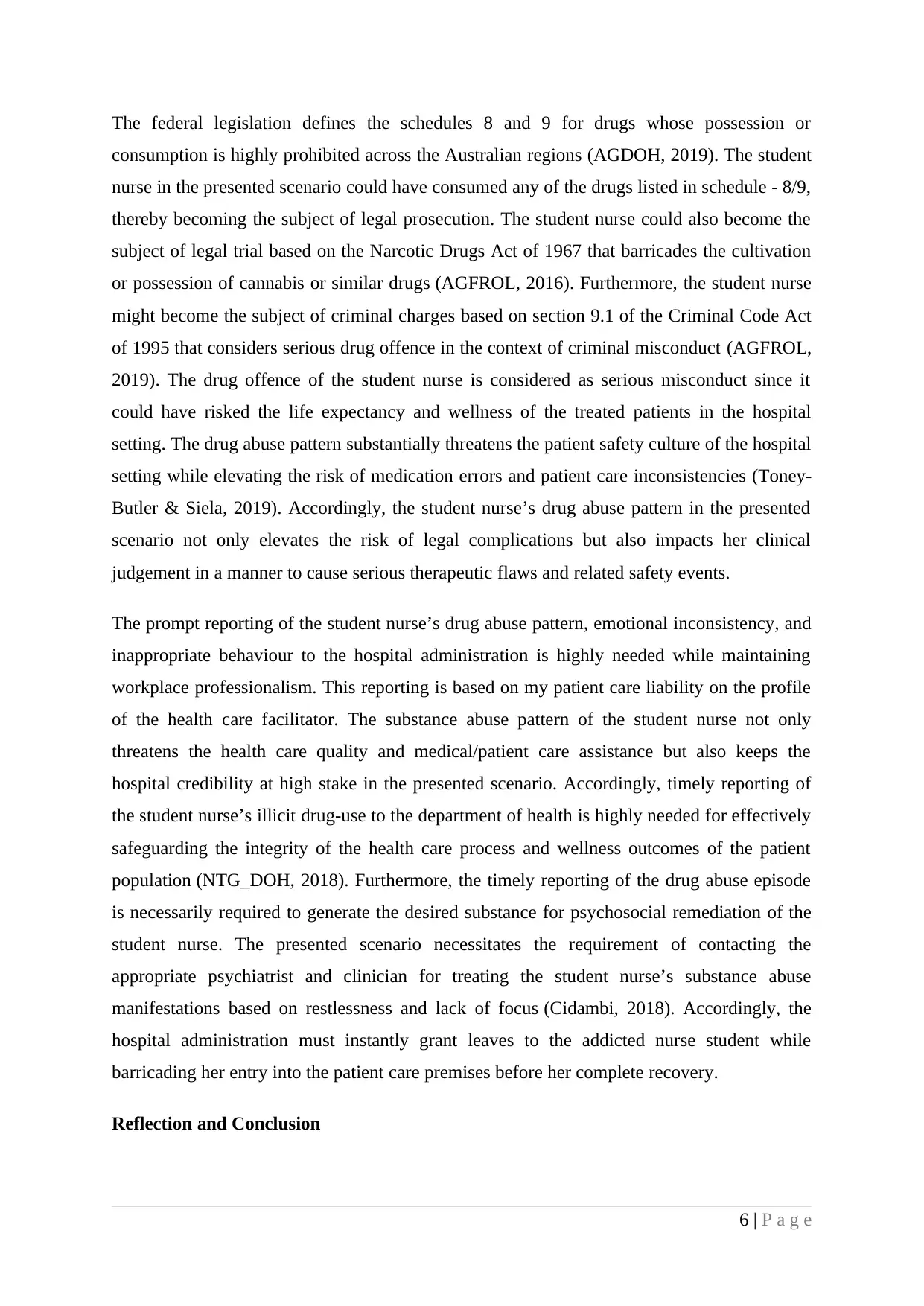
The federal legislation defines the schedules 8 and 9 for drugs whose possession or
consumption is highly prohibited across the Australian regions (AGDOH, 2019). The student
nurse in the presented scenario could have consumed any of the drugs listed in schedule - 8/9,
thereby becoming the subject of legal prosecution. The student nurse could also become the
subject of legal trial based on the Narcotic Drugs Act of 1967 that barricades the cultivation
or possession of cannabis or similar drugs (AGFROL, 2016). Furthermore, the student nurse
might become the subject of criminal charges based on section 9.1 of the Criminal Code Act
of 1995 that considers serious drug offence in the context of criminal misconduct (AGFROL,
2019). The drug offence of the student nurse is considered as serious misconduct since it
could have risked the life expectancy and wellness of the treated patients in the hospital
setting. The drug abuse pattern substantially threatens the patient safety culture of the hospital
setting while elevating the risk of medication errors and patient care inconsistencies (Toney-
Butler & Siela, 2019). Accordingly, the student nurse’s drug abuse pattern in the presented
scenario not only elevates the risk of legal complications but also impacts her clinical
judgement in a manner to cause serious therapeutic flaws and related safety events.
The prompt reporting of the student nurse’s drug abuse pattern, emotional inconsistency, and
inappropriate behaviour to the hospital administration is highly needed while maintaining
workplace professionalism. This reporting is based on my patient care liability on the profile
of the health care facilitator. The substance abuse pattern of the student nurse not only
threatens the health care quality and medical/patient care assistance but also keeps the
hospital credibility at high stake in the presented scenario. Accordingly, timely reporting of
the student nurse’s illicit drug-use to the department of health is highly needed for effectively
safeguarding the integrity of the health care process and wellness outcomes of the patient
population (NTG_DOH, 2018). Furthermore, the timely reporting of the drug abuse episode
is necessarily required to generate the desired substance for psychosocial remediation of the
student nurse. The presented scenario necessitates the requirement of contacting the
appropriate psychiatrist and clinician for treating the student nurse’s substance abuse
manifestations based on restlessness and lack of focus (Cidambi, 2018). Accordingly, the
hospital administration must instantly grant leaves to the addicted nurse student while
barricading her entry into the patient care premises before her complete recovery.
Reflection and Conclusion
6 | P a g e
consumption is highly prohibited across the Australian regions (AGDOH, 2019). The student
nurse in the presented scenario could have consumed any of the drugs listed in schedule - 8/9,
thereby becoming the subject of legal prosecution. The student nurse could also become the
subject of legal trial based on the Narcotic Drugs Act of 1967 that barricades the cultivation
or possession of cannabis or similar drugs (AGFROL, 2016). Furthermore, the student nurse
might become the subject of criminal charges based on section 9.1 of the Criminal Code Act
of 1995 that considers serious drug offence in the context of criminal misconduct (AGFROL,
2019). The drug offence of the student nurse is considered as serious misconduct since it
could have risked the life expectancy and wellness of the treated patients in the hospital
setting. The drug abuse pattern substantially threatens the patient safety culture of the hospital
setting while elevating the risk of medication errors and patient care inconsistencies (Toney-
Butler & Siela, 2019). Accordingly, the student nurse’s drug abuse pattern in the presented
scenario not only elevates the risk of legal complications but also impacts her clinical
judgement in a manner to cause serious therapeutic flaws and related safety events.
The prompt reporting of the student nurse’s drug abuse pattern, emotional inconsistency, and
inappropriate behaviour to the hospital administration is highly needed while maintaining
workplace professionalism. This reporting is based on my patient care liability on the profile
of the health care facilitator. The substance abuse pattern of the student nurse not only
threatens the health care quality and medical/patient care assistance but also keeps the
hospital credibility at high stake in the presented scenario. Accordingly, timely reporting of
the student nurse’s illicit drug-use to the department of health is highly needed for effectively
safeguarding the integrity of the health care process and wellness outcomes of the patient
population (NTG_DOH, 2018). Furthermore, the timely reporting of the drug abuse episode
is necessarily required to generate the desired substance for psychosocial remediation of the
student nurse. The presented scenario necessitates the requirement of contacting the
appropriate psychiatrist and clinician for treating the student nurse’s substance abuse
manifestations based on restlessness and lack of focus (Cidambi, 2018). Accordingly, the
hospital administration must instantly grant leaves to the addicted nurse student while
barricading her entry into the patient care premises before her complete recovery.
Reflection and Conclusion
6 | P a g e
⊘ This is a preview!⊘
Do you want full access?
Subscribe today to unlock all pages.

Trusted by 1+ million students worldwide
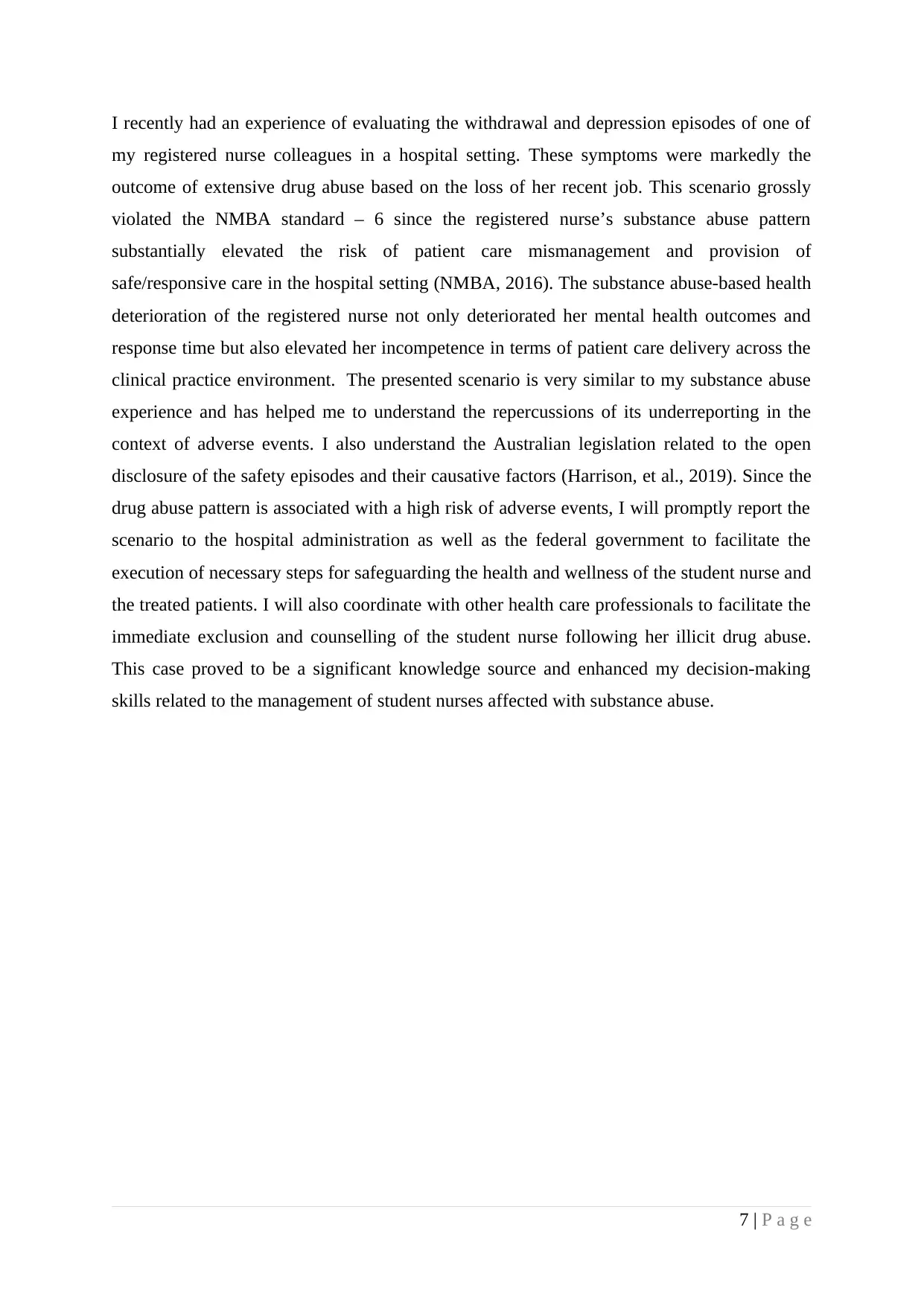
I recently had an experience of evaluating the withdrawal and depression episodes of one of
my registered nurse colleagues in a hospital setting. These symptoms were markedly the
outcome of extensive drug abuse based on the loss of her recent job. This scenario grossly
violated the NMBA standard – 6 since the registered nurse’s substance abuse pattern
substantially elevated the risk of patient care mismanagement and provision of
safe/responsive care in the hospital setting (NMBA, 2016). The substance abuse-based health
deterioration of the registered nurse not only deteriorated her mental health outcomes and
response time but also elevated her incompetence in terms of patient care delivery across the
clinical practice environment. The presented scenario is very similar to my substance abuse
experience and has helped me to understand the repercussions of its underreporting in the
context of adverse events. I also understand the Australian legislation related to the open
disclosure of the safety episodes and their causative factors (Harrison, et al., 2019). Since the
drug abuse pattern is associated with a high risk of adverse events, I will promptly report the
scenario to the hospital administration as well as the federal government to facilitate the
execution of necessary steps for safeguarding the health and wellness of the student nurse and
the treated patients. I will also coordinate with other health care professionals to facilitate the
immediate exclusion and counselling of the student nurse following her illicit drug abuse.
This case proved to be a significant knowledge source and enhanced my decision-making
skills related to the management of student nurses affected with substance abuse.
7 | P a g e
my registered nurse colleagues in a hospital setting. These symptoms were markedly the
outcome of extensive drug abuse based on the loss of her recent job. This scenario grossly
violated the NMBA standard – 6 since the registered nurse’s substance abuse pattern
substantially elevated the risk of patient care mismanagement and provision of
safe/responsive care in the hospital setting (NMBA, 2016). The substance abuse-based health
deterioration of the registered nurse not only deteriorated her mental health outcomes and
response time but also elevated her incompetence in terms of patient care delivery across the
clinical practice environment. The presented scenario is very similar to my substance abuse
experience and has helped me to understand the repercussions of its underreporting in the
context of adverse events. I also understand the Australian legislation related to the open
disclosure of the safety episodes and their causative factors (Harrison, et al., 2019). Since the
drug abuse pattern is associated with a high risk of adverse events, I will promptly report the
scenario to the hospital administration as well as the federal government to facilitate the
execution of necessary steps for safeguarding the health and wellness of the student nurse and
the treated patients. I will also coordinate with other health care professionals to facilitate the
immediate exclusion and counselling of the student nurse following her illicit drug abuse.
This case proved to be a significant knowledge source and enhanced my decision-making
skills related to the management of student nurses affected with substance abuse.
7 | P a g e
Paraphrase This Document
Need a fresh take? Get an instant paraphrase of this document with our AI Paraphraser
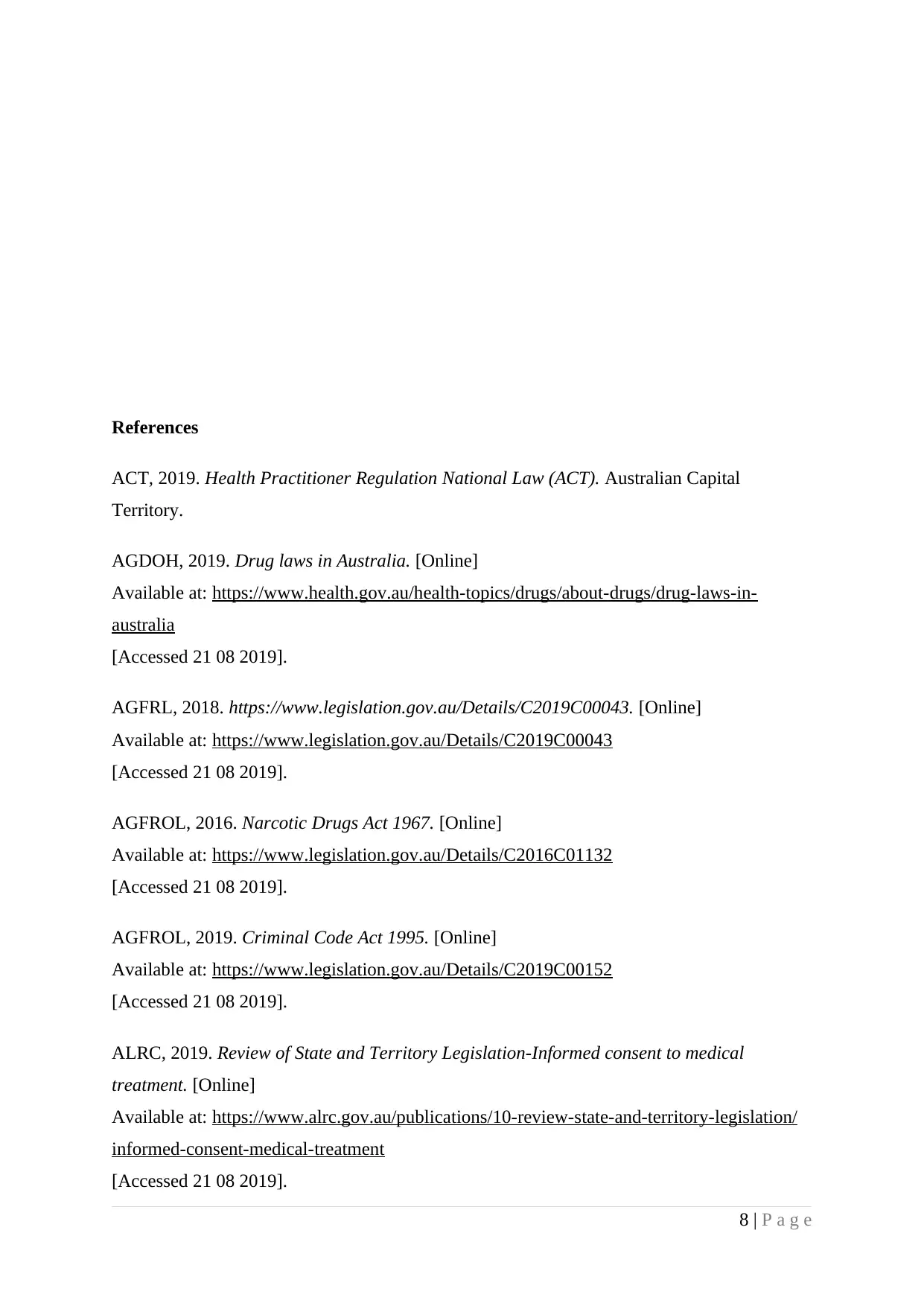
References
ACT, 2019. Health Practitioner Regulation National Law (ACT). Australian Capital
Territory.
AGDOH, 2019. Drug laws in Australia. [Online]
Available at: https://www.health.gov.au/health-topics/drugs/about-drugs/drug-laws-in-
australia
[Accessed 21 08 2019].
AGFRL, 2018. https://www.legislation.gov.au/Details/C2019C00043. [Online]
Available at: https://www.legislation.gov.au/Details/C2019C00043
[Accessed 21 08 2019].
AGFROL, 2016. Narcotic Drugs Act 1967. [Online]
Available at: https://www.legislation.gov.au/Details/C2016C01132
[Accessed 21 08 2019].
AGFROL, 2019. Criminal Code Act 1995. [Online]
Available at: https://www.legislation.gov.au/Details/C2019C00152
[Accessed 21 08 2019].
ALRC, 2019. Review of State and Territory Legislation-Informed consent to medical
treatment. [Online]
Available at: https://www.alrc.gov.au/publications/10-review-state-and-territory-legislation/
informed-consent-medical-treatment
[Accessed 21 08 2019].
8 | P a g e
ACT, 2019. Health Practitioner Regulation National Law (ACT). Australian Capital
Territory.
AGDOH, 2019. Drug laws in Australia. [Online]
Available at: https://www.health.gov.au/health-topics/drugs/about-drugs/drug-laws-in-
australia
[Accessed 21 08 2019].
AGFRL, 2018. https://www.legislation.gov.au/Details/C2019C00043. [Online]
Available at: https://www.legislation.gov.au/Details/C2019C00043
[Accessed 21 08 2019].
AGFROL, 2016. Narcotic Drugs Act 1967. [Online]
Available at: https://www.legislation.gov.au/Details/C2016C01132
[Accessed 21 08 2019].
AGFROL, 2019. Criminal Code Act 1995. [Online]
Available at: https://www.legislation.gov.au/Details/C2019C00152
[Accessed 21 08 2019].
ALRC, 2019. Review of State and Territory Legislation-Informed consent to medical
treatment. [Online]
Available at: https://www.alrc.gov.au/publications/10-review-state-and-territory-legislation/
informed-consent-medical-treatment
[Accessed 21 08 2019].
8 | P a g e
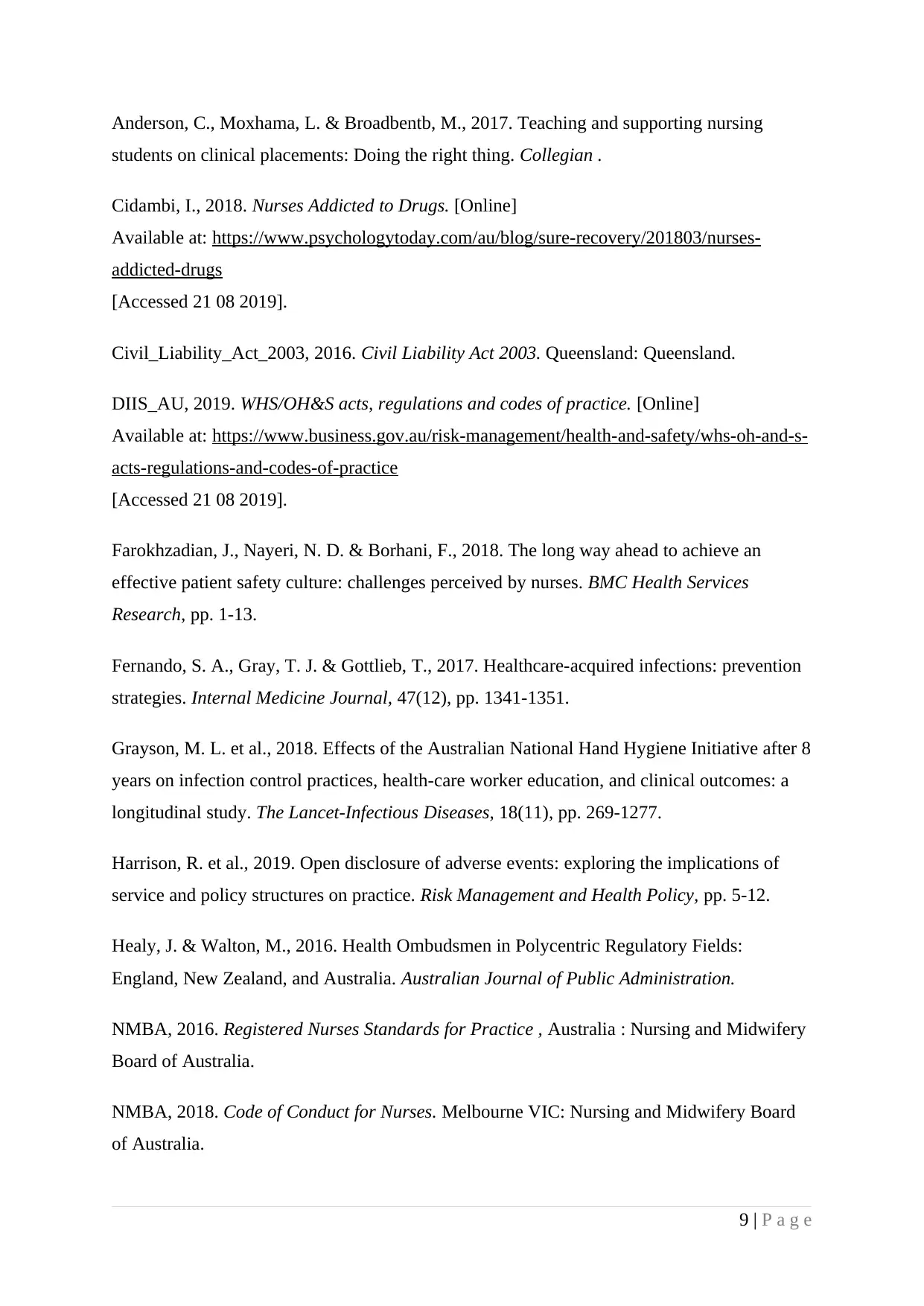
Anderson, C., Moxhama, L. & Broadbentb, M., 2017. Teaching and supporting nursing
students on clinical placements: Doing the right thing. Collegian .
Cidambi, I., 2018. Nurses Addicted to Drugs. [Online]
Available at: https://www.psychologytoday.com/au/blog/sure-recovery/201803/nurses-
addicted-drugs
[Accessed 21 08 2019].
Civil_Liability_Act_2003, 2016. Civil Liability Act 2003. Queensland: Queensland.
DIIS_AU, 2019. WHS/OH&S acts, regulations and codes of practice. [Online]
Available at: https://www.business.gov.au/risk-management/health-and-safety/whs-oh-and-s-
acts-regulations-and-codes-of-practice
[Accessed 21 08 2019].
Farokhzadian, J., Nayeri, N. D. & Borhani, F., 2018. The long way ahead to achieve an
effective patient safety culture: challenges perceived by nurses. BMC Health Services
Research, pp. 1-13.
Fernando, S. A., Gray, T. J. & Gottlieb, T., 2017. Healthcare-acquired infections: prevention
strategies. Internal Medicine Journal, 47(12), pp. 1341-1351.
Grayson, M. L. et al., 2018. Effects of the Australian National Hand Hygiene Initiative after 8
years on infection control practices, health-care worker education, and clinical outcomes: a
longitudinal study. The Lancet-Infectious Diseases, 18(11), pp. 269-1277.
Harrison, R. et al., 2019. Open disclosure of adverse events: exploring the implications of
service and policy structures on practice. Risk Management and Health Policy, pp. 5-12.
Healy, J. & Walton, M., 2016. Health Ombudsmen in Polycentric Regulatory Fields:
England, New Zealand, and Australia. Australian Journal of Public Administration.
NMBA, 2016. Registered Nurses Standards for Practice , Australia : Nursing and Midwifery
Board of Australia.
NMBA, 2018. Code of Conduct for Nurses. Melbourne VIC: Nursing and Midwifery Board
of Australia.
9 | P a g e
students on clinical placements: Doing the right thing. Collegian .
Cidambi, I., 2018. Nurses Addicted to Drugs. [Online]
Available at: https://www.psychologytoday.com/au/blog/sure-recovery/201803/nurses-
addicted-drugs
[Accessed 21 08 2019].
Civil_Liability_Act_2003, 2016. Civil Liability Act 2003. Queensland: Queensland.
DIIS_AU, 2019. WHS/OH&S acts, regulations and codes of practice. [Online]
Available at: https://www.business.gov.au/risk-management/health-and-safety/whs-oh-and-s-
acts-regulations-and-codes-of-practice
[Accessed 21 08 2019].
Farokhzadian, J., Nayeri, N. D. & Borhani, F., 2018. The long way ahead to achieve an
effective patient safety culture: challenges perceived by nurses. BMC Health Services
Research, pp. 1-13.
Fernando, S. A., Gray, T. J. & Gottlieb, T., 2017. Healthcare-acquired infections: prevention
strategies. Internal Medicine Journal, 47(12), pp. 1341-1351.
Grayson, M. L. et al., 2018. Effects of the Australian National Hand Hygiene Initiative after 8
years on infection control practices, health-care worker education, and clinical outcomes: a
longitudinal study. The Lancet-Infectious Diseases, 18(11), pp. 269-1277.
Harrison, R. et al., 2019. Open disclosure of adverse events: exploring the implications of
service and policy structures on practice. Risk Management and Health Policy, pp. 5-12.
Healy, J. & Walton, M., 2016. Health Ombudsmen in Polycentric Regulatory Fields:
England, New Zealand, and Australia. Australian Journal of Public Administration.
NMBA, 2016. Registered Nurses Standards for Practice , Australia : Nursing and Midwifery
Board of Australia.
NMBA, 2018. Code of Conduct for Nurses. Melbourne VIC: Nursing and Midwifery Board
of Australia.
9 | P a g e
⊘ This is a preview!⊘
Do you want full access?
Subscribe today to unlock all pages.

Trusted by 1+ million students worldwide
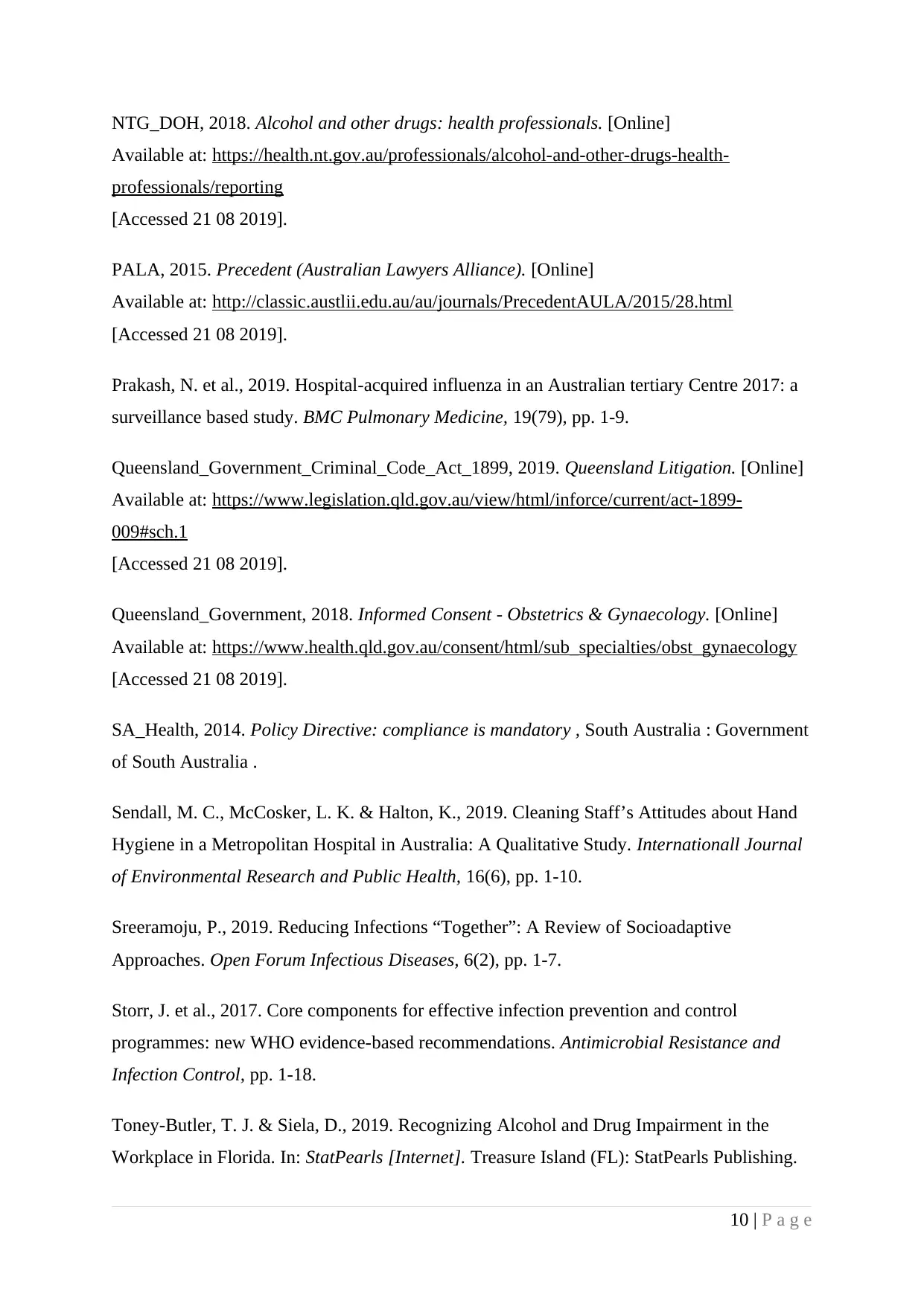
NTG_DOH, 2018. Alcohol and other drugs: health professionals. [Online]
Available at: https://health.nt.gov.au/professionals/alcohol-and-other-drugs-health-
professionals/reporting
[Accessed 21 08 2019].
PALA, 2015. Precedent (Australian Lawyers Alliance). [Online]
Available at: http://classic.austlii.edu.au/au/journals/PrecedentAULA/2015/28.html
[Accessed 21 08 2019].
Prakash, N. et al., 2019. Hospital-acquired influenza in an Australian tertiary Centre 2017: a
surveillance based study. BMC Pulmonary Medicine, 19(79), pp. 1-9.
Queensland_Government_Criminal_Code_Act_1899, 2019. Queensland Litigation. [Online]
Available at: https://www.legislation.qld.gov.au/view/html/inforce/current/act-1899-
009#sch.1
[Accessed 21 08 2019].
Queensland_Government, 2018. Informed Consent - Obstetrics & Gynaecology. [Online]
Available at: https://www.health.qld.gov.au/consent/html/sub_specialties/obst_gynaecology
[Accessed 21 08 2019].
SA_Health, 2014. Policy Directive: compliance is mandatory , South Australia : Government
of South Australia .
Sendall, M. C., McCosker, L. K. & Halton, K., 2019. Cleaning Staff’s Attitudes about Hand
Hygiene in a Metropolitan Hospital in Australia: A Qualitative Study. Internationall Journal
of Environmental Research and Public Health, 16(6), pp. 1-10.
Sreeramoju, P., 2019. Reducing Infections “Together”: A Review of Socioadaptive
Approaches. Open Forum Infectious Diseases, 6(2), pp. 1-7.
Storr, J. et al., 2017. Core components for effective infection prevention and control
programmes: new WHO evidence-based recommendations. Antimicrobial Resistance and
Infection Control, pp. 1-18.
Toney-Butler, T. J. & Siela, D., 2019. Recognizing Alcohol and Drug Impairment in the
Workplace in Florida. In: StatPearls [Internet]. Treasure Island (FL): StatPearls Publishing.
10 | P a g e
Available at: https://health.nt.gov.au/professionals/alcohol-and-other-drugs-health-
professionals/reporting
[Accessed 21 08 2019].
PALA, 2015. Precedent (Australian Lawyers Alliance). [Online]
Available at: http://classic.austlii.edu.au/au/journals/PrecedentAULA/2015/28.html
[Accessed 21 08 2019].
Prakash, N. et al., 2019. Hospital-acquired influenza in an Australian tertiary Centre 2017: a
surveillance based study. BMC Pulmonary Medicine, 19(79), pp. 1-9.
Queensland_Government_Criminal_Code_Act_1899, 2019. Queensland Litigation. [Online]
Available at: https://www.legislation.qld.gov.au/view/html/inforce/current/act-1899-
009#sch.1
[Accessed 21 08 2019].
Queensland_Government, 2018. Informed Consent - Obstetrics & Gynaecology. [Online]
Available at: https://www.health.qld.gov.au/consent/html/sub_specialties/obst_gynaecology
[Accessed 21 08 2019].
SA_Health, 2014. Policy Directive: compliance is mandatory , South Australia : Government
of South Australia .
Sendall, M. C., McCosker, L. K. & Halton, K., 2019. Cleaning Staff’s Attitudes about Hand
Hygiene in a Metropolitan Hospital in Australia: A Qualitative Study. Internationall Journal
of Environmental Research and Public Health, 16(6), pp. 1-10.
Sreeramoju, P., 2019. Reducing Infections “Together”: A Review of Socioadaptive
Approaches. Open Forum Infectious Diseases, 6(2), pp. 1-7.
Storr, J. et al., 2017. Core components for effective infection prevention and control
programmes: new WHO evidence-based recommendations. Antimicrobial Resistance and
Infection Control, pp. 1-18.
Toney-Butler, T. J. & Siela, D., 2019. Recognizing Alcohol and Drug Impairment in the
Workplace in Florida. In: StatPearls [Internet]. Treasure Island (FL): StatPearls Publishing.
10 | P a g e
Paraphrase This Document
Need a fresh take? Get an instant paraphrase of this document with our AI Paraphraser
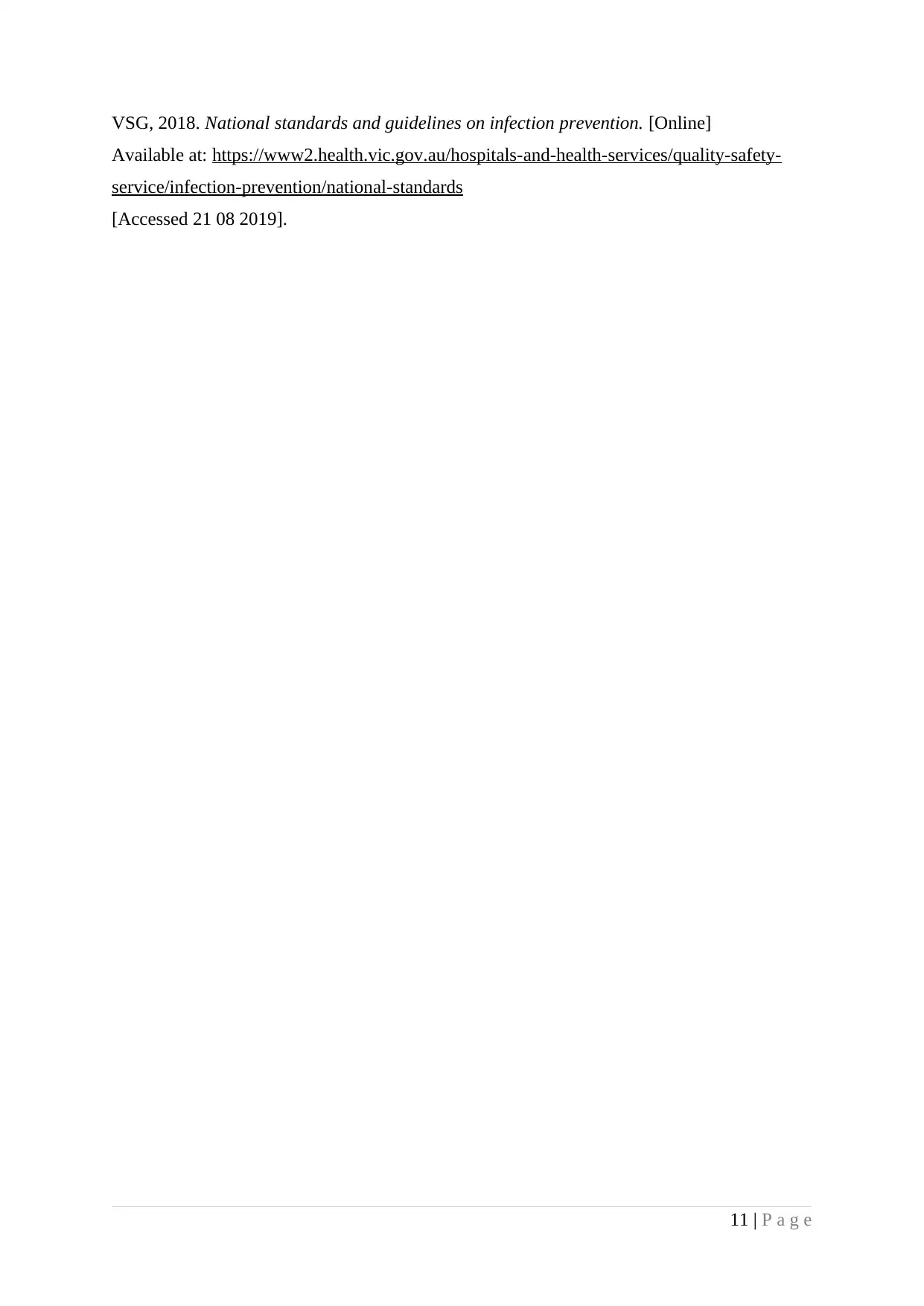
VSG, 2018. National standards and guidelines on infection prevention. [Online]
Available at: https://www2.health.vic.gov.au/hospitals-and-health-services/quality-safety-
service/infection-prevention/national-standards
[Accessed 21 08 2019].
11 | P a g e
Available at: https://www2.health.vic.gov.au/hospitals-and-health-services/quality-safety-
service/infection-prevention/national-standards
[Accessed 21 08 2019].
11 | P a g e
1 out of 11
Related Documents
Your All-in-One AI-Powered Toolkit for Academic Success.
+13062052269
info@desklib.com
Available 24*7 on WhatsApp / Email
![[object Object]](/_next/static/media/star-bottom.7253800d.svg)
Unlock your academic potential
Copyright © 2020–2025 A2Z Services. All Rights Reserved. Developed and managed by ZUCOL.




